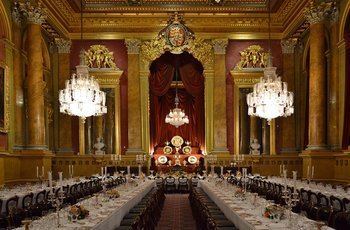 | ||
Similar Birmingham Assay Office, Mansion House - London, Guildhall - London, The Scottish Gallery, St Vedast Foster Lane | ||
Goldsmiths' Hall is a Grade I building at the junction of Foster Lane and Gresham Street in the City of London. It has served as an assay office and the headquarters of London's goldsmith guild, the Worshipful Company of Goldsmiths, one of the livery companies of the City of London.
Map of Goldsmiths' Hall, London EC2V, UK
The Company has been based at this location since 1339, the present building being their third hall on the site.
Little is known about the first hall. The second hall was built circa 1634-36 and restored after the Great Fire of London in 1666; it was eventually demolished in the late 1820s. The third and present hall was designed by Philip Hardwick. The hall is entirely detached, and occupies an entire block. Despite its great size, it is the second largest livery hall after the Worshipful Company of Plaisterers' Plaisterers Hall at One London Wall. Those present at the opening dinner in 1835 included the Duke of Wellington and Robert Peel. In 1941 a bomb exploded in its southwest corner, but amazingly the building largely survived and was restored after the World War II.
From time to time, the Master and Wardens provide for open days to visit Goldsmiths' Hall.
Samuel Pepys viewed the funeral of Sir Thomas Vyner from Goldsmiths' Hall. Pepys wore his best silk suit for the occasion, but the hall was so full of people that he left for Paternoster Square to order a new, ordinary silk suit.
The process by which members of the hall evaluated and stamped precious metals gave rise to the term hallmarking; the corresponding impression is known as a hallmark. Originally, a hallmark was impressed or engraved on ingots of gold and silver to certify their composition and weight. The term is now more commonly used figuratively.
